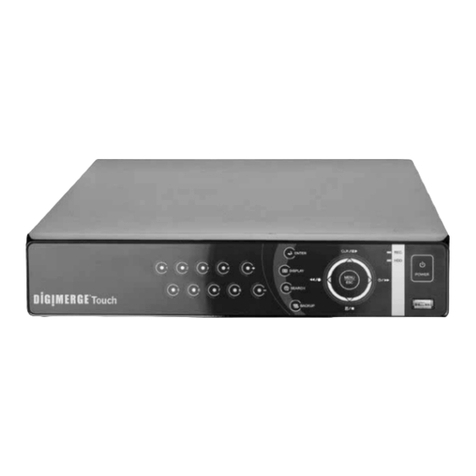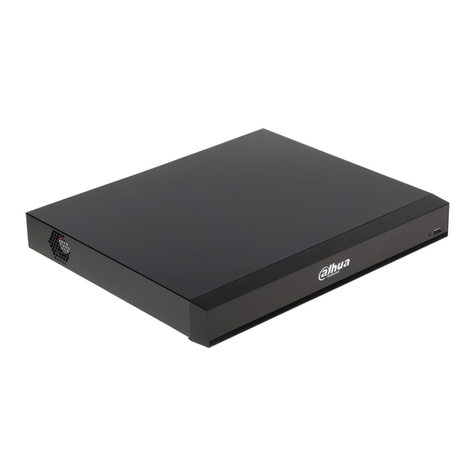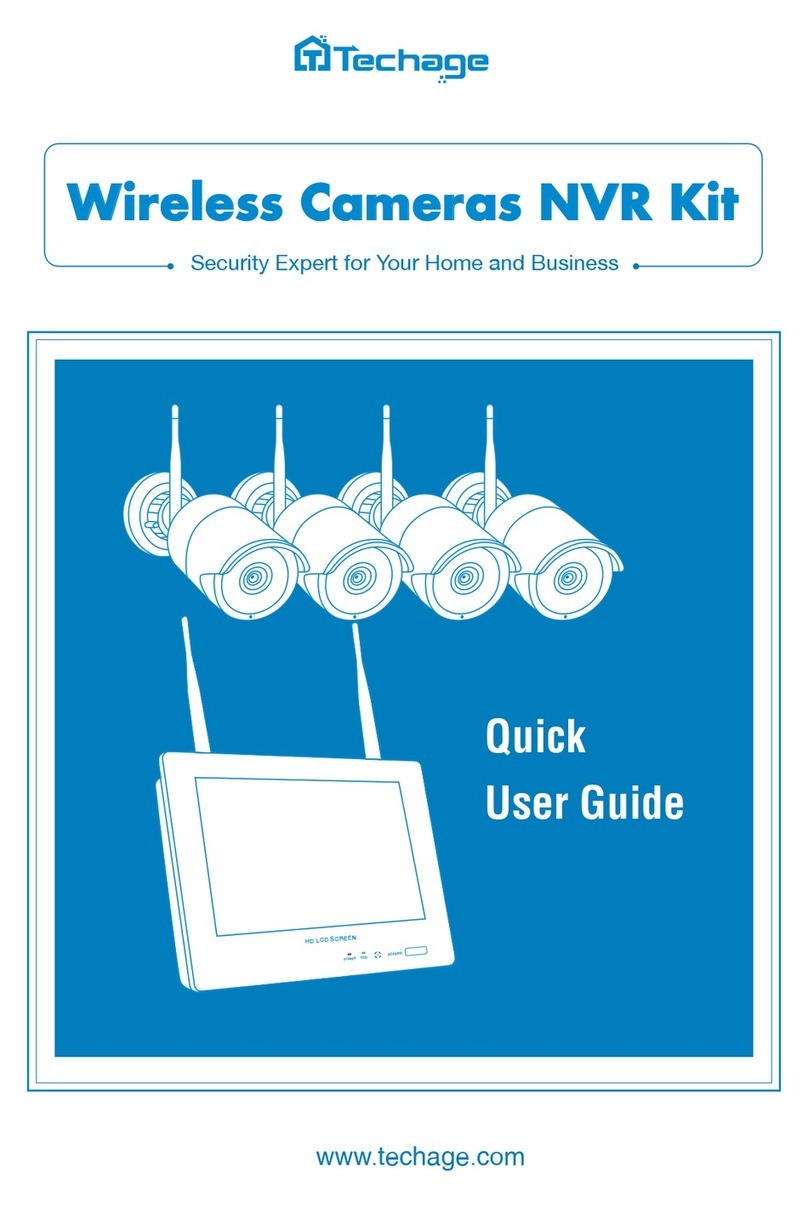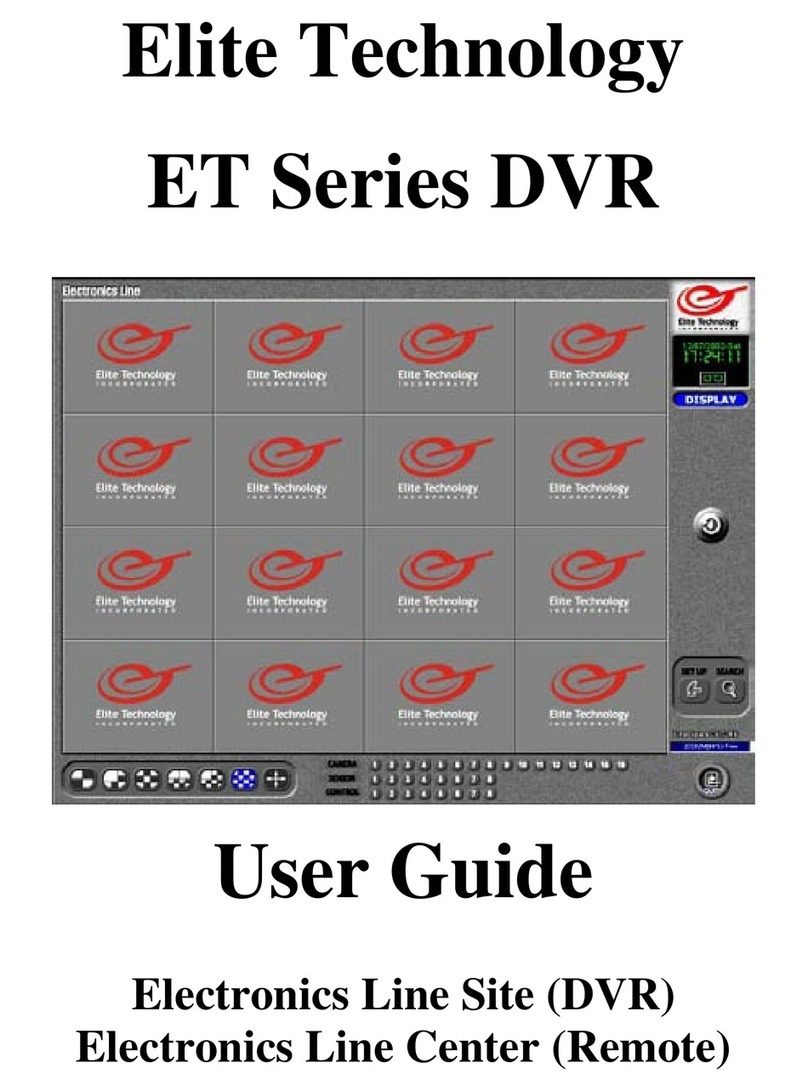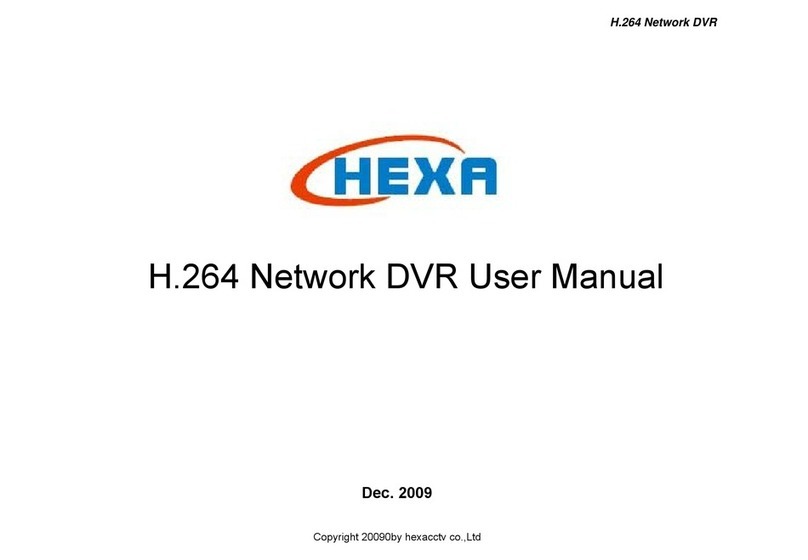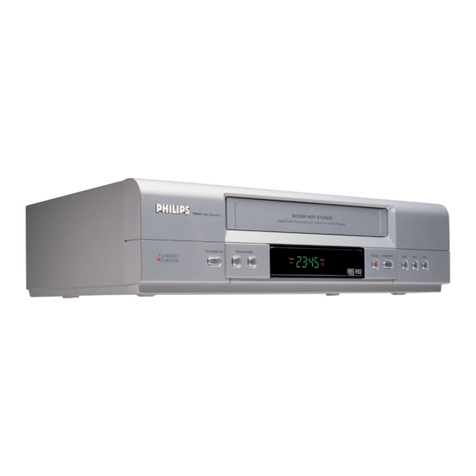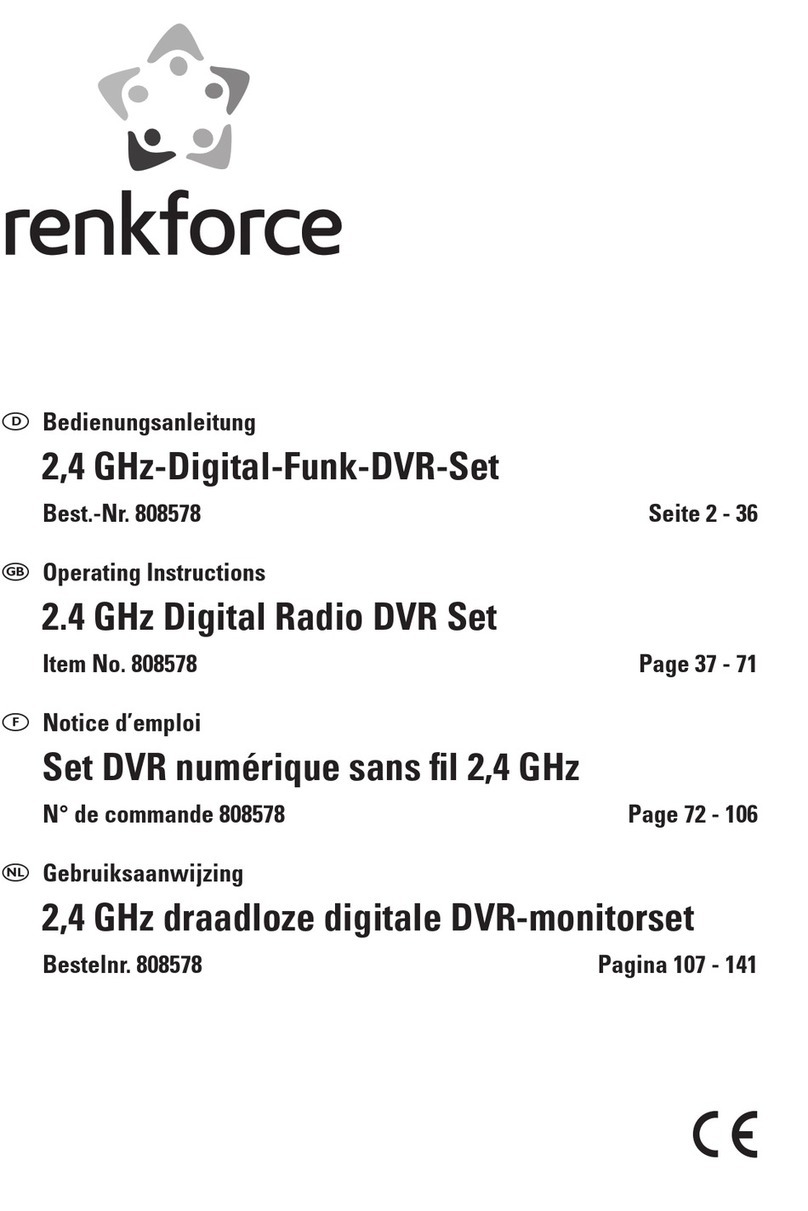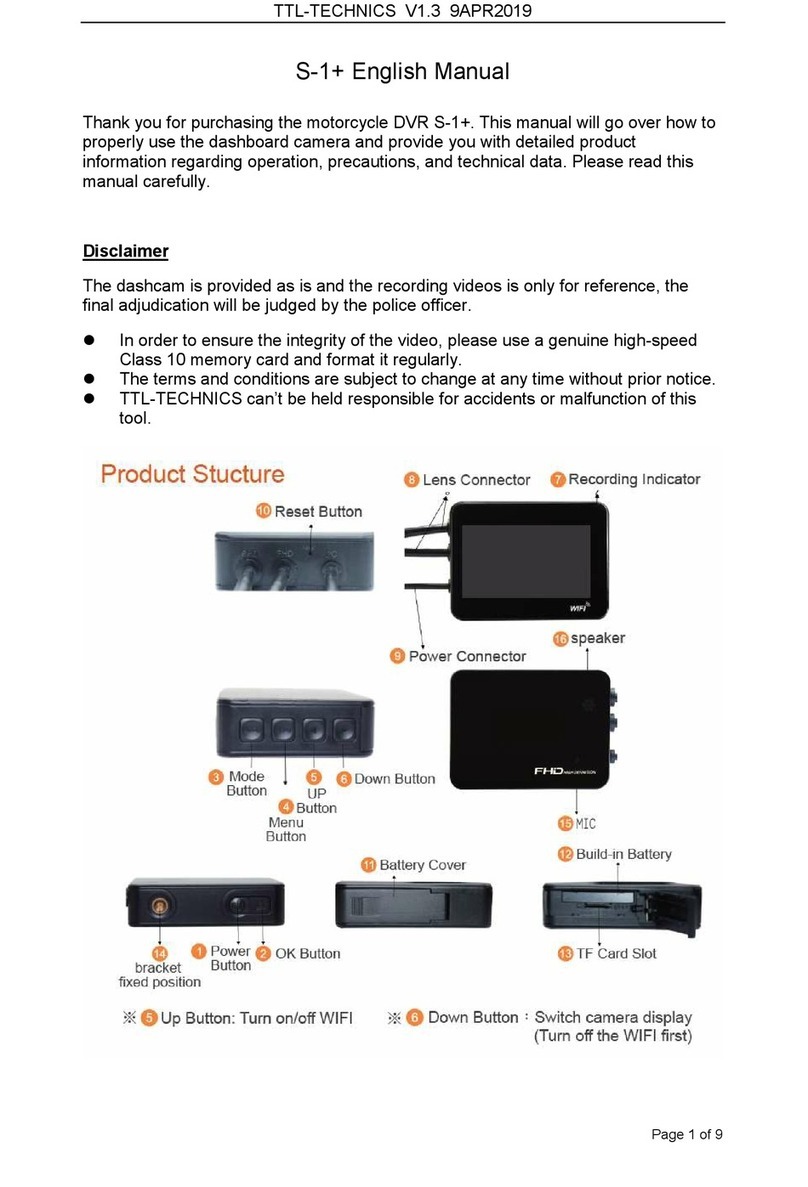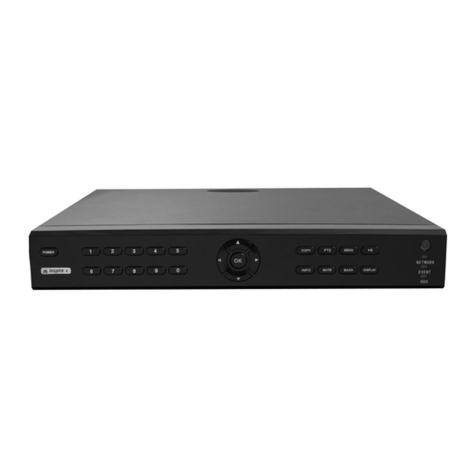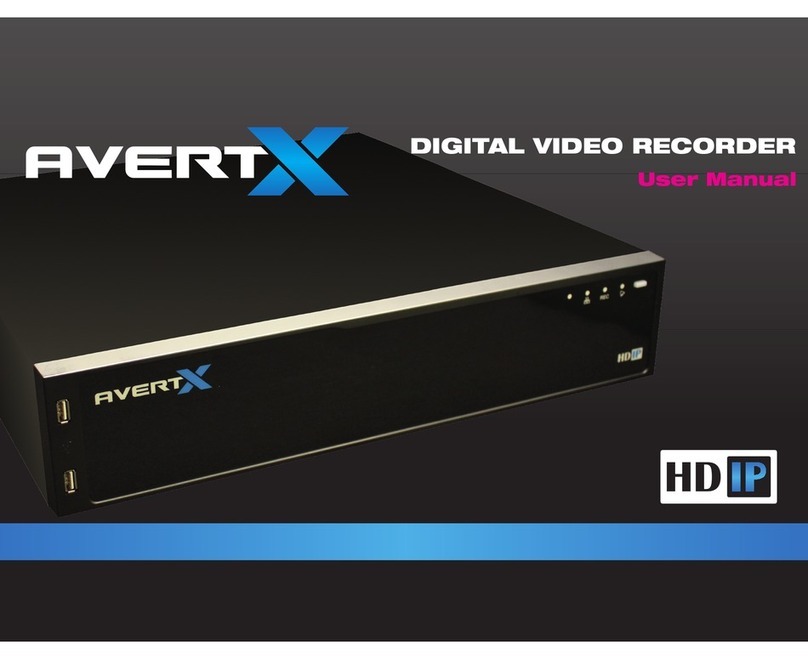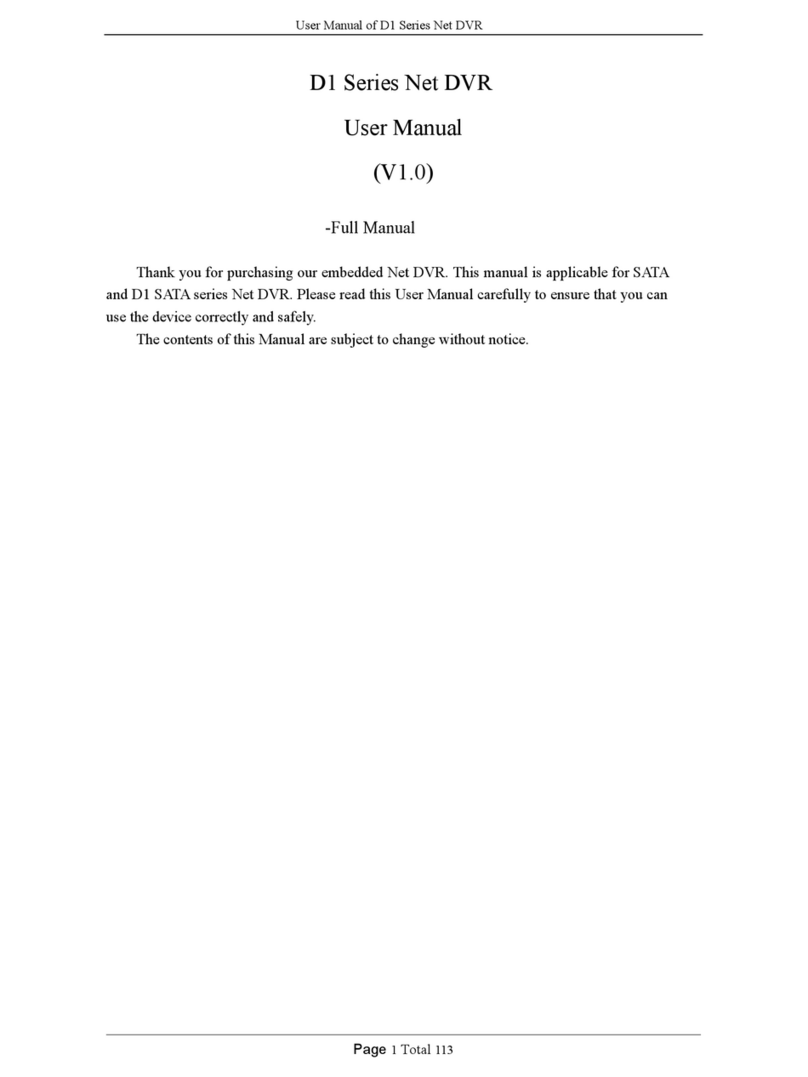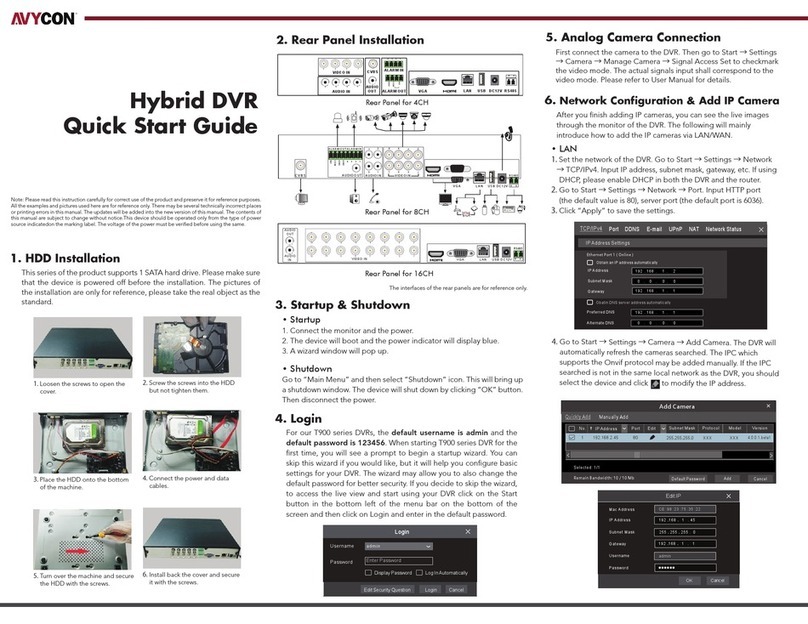MICRO-D H.264 Instruction Manual

1
MICRO-D Manual V.1.3
H.264 DVR
MICRO-D
Installation &
User’s Manual
※
The contents of the manual can be modified without prior notice to customers

2
MICRO-D Manual V.1.3
GENERAL SAFETY AND PRECAUTIONS
The MICRO-D is manufactured to meet international safety standards. Read the following safety
precautions to avoid injury and prevent damage to the MICRO-D or any products connected to it.
1. Use a correct power source. Do not connect this product to a power source that supplies more
than the specified voltage (DC12V), as this will cause damage to the unit.
2. Never insert anything metallic into the MICRO-D as this can cause electric shock.
3. Do not operate in wet & dusty conditions. Keep product surfaces clean and dry. Avoid placing the
MICRO-D in areas like a damp basement or a dusty hallway.
4. Do not expose this product to rain or use near water. If the product gets wet, unplug it and
contact an authorized dealer immediately.
5. To clean the outside case of the MICRO-D, use a lightly dampened cloth (no solvents).
6. Do not operate if you suspected to unit is faulty. If there are any unusual sounds or smells
coming from the MICRO-D, immediately unplug it and contact an authorized dealer or service
centre.
7. Do not attempt to remove the top cover.
8. Warning: Removing the MICRO-D’s cover can cause an electrical shock.
9. Handle MICRO-D carefully to avoid damaging the product. Dropping your MICRO-D on any hard
surface may cause the unit to malfunction. If the MICRO-D does not work properly due to
physical damage, contact an authorized dealer for repair or exchange.
10.The unit has a lithium battery preinstalled.
The standard lithium cell 3V battery located on the motherboard should be replaced if the time
clock does not hold its time after the power is turned off.
Warning:
Unplug the MICRO-D before replacing battery or you may be subjected to severe electrical shock.
Properly dispose of old batteries.
Caution:
Risk of explosion if battery is replaced by an incorrect type. Do not discard lithium batteries into the
trash can or into fire. Dispose in accordance with local waste regulations.
Information to user
The user’s manual or instruction manual for an intentional or unintentional radiator shall caution the
user that changes or modifications not expressly approved by the party responsible for compliance
could void the user’s authority to operate the equipment.

3
MICRO-D Manual V.1.3
TABLE OF CONTENTS
Chapter 1: Packing Contents
CONTENTS IN THE PACKAGE 5
Chapter 2: Getting To Know Your MICRO-D
MICRO-D 6
Chapter 3: Remote control
REMOTE CONTROL PANEL 8
Chapter 4: Getting Started
OVERVIEW OF SET UP PROCEDURES 10
Chapter 5: Hardware Installation
SD MEMORY INSTALLATION 11
CONNECTING MICRO-D TO YOUR TV SET OR MONITOR 11
ALARM INSTALLATION 13
Chapter 6: OSD MODE
1. ACCESS TO OSD MENU 14
2. MAIN MENU 14
3. SYSTEM SETUP
3.1 TIME & DATE OVERLAY
3.2 TIME SET > DAY LIGHT SAVING
3.3 TIME CORRECTION
3.4 LANGUAGE SETUP
3.5 VIDEO OUTPUT
3.6 BRIGHTNESS
15
4. VIDEO SETUP
4.1 RESOLUTION
4.2 VIDEO QUALITY
4.3 FRAME RATE
4.4 PRE RECORDING TIME
4.5 POST RECORDING TIME
4.6 AUDIO INPUT LEVEL
4.7 AUTO RECORDING
4.8 DISK OVERWRITE
17

4
MICRO-D Manual V.1.3
5. EVENT SETUP
5.1 ALARM SETUP
5.1.1 ALARM INPUT
5.1.2 INPUT TYPE
5.1.3 ALARM OUTPUT
5.1.4 ALARM CONTINUE
5.2 MOTION DETECTION
5.2.1 SENSITIVITY
5.3 SCHEDULE SETUP
5.3.1 TIME
5.3.2 TIME AND EVENT
19
6. SUB MENU
6.1 PASSWORD CHANGE
6.2 FILE INDEX RENEW
20
Chapter 7: SCREEN MODE
1. LIVE SCREEN MODE
1.1 SCREEN MESSAGE
1.2 SCREEN ICON
21
2. SEARCH MODE
2.1 SEARCH LIST
2.2 SEARCH FACTOR
2.2.1 SEARCH FACTOR – TIME
2.2.2 SEARCH FACTOR – EVENT
2.2.3 SEARCH FACTOR – BOTH
2.2.4 SEARCH FACTOR – NONE
2.3 PLAYBACK SCREEN VIEW
23
Appendix:
TECHNICAL SPECIFICATIONS 25
APPROXIMATE RECORDING TIME TABLE
27

5
MICRO-D Manual V.1.3
Chapter 1: Packing Contents
▶Contents in the package
MICRO-D Main Unit Remote Controller AV-IN / AV-OUT Connector
Terminal Block 12V Power Supply Installation CD
Quick Guide Max. 32GB SD card
Can be used(Option)
SD Reader (Option)

6
MICRO-D Manual V.1.3
Chapter 2: Getting To Know Your MICRO-D
▶MICRO-D
This chapter briefly describes the functions of each button on MICRO-D. The buttons are used to operate
the basic functions of MICRO-D, such as recording, playback, fast-forward, reverse play and etc. For more
details on the set-up and operation of MICRO-D, refer to Chapter 6, MICRO-D MENU.
①
②
③⑤
⑥
⑦
⑧⑨ ⑩
④

7
MICRO-D Manual V.1.3
1Sensor-in / Alarm-out
The sensor-in is installed to connect Sensor Terminal Block on the main body of MICRO-D and alarm
activates when event occurs. If you add motion sensor devices to your MICRO-D, the video recording
can be triggered by event. The alarm output terminal is used to install a single alarm device.
2SD Memory Slot
Insert or remove the SD CARD.
3Recording LED
GREEN LED turns on during Recording mode.
4Status LED
STA LED turns on when Event occurs or Error.
(Recording Mode: GREEN LED ON & ORANGE LED BLINK, Error: ORANGE LED BLINK)
5Power LED
RED LED turns on when power is up.
6Remote control Receiver
When controlling MICRO-D by remote control, be sure to point at the receiver.
7Reset
Product returns to default value.
8AV-IN
AUDIO/VIDEO INPUT PORT
9 AV-OUT
AUDIO/VIDEO OUTPUT PORT
10 Power
12V POWER INPUT PORT

8
MICRO-D Manual V.1.3
Chapter 3: Remote control
1 REC Start EMERGENCY RECORDING or stops recording.
2 MENU Enter & Exit from OSD menu mode.
3
UP/
DOWN
Change values from OSD menu.
On SEARCH MODE, find recorded files.
4
LEFT/
RIGHT
Change values from OSD menu.
REW: Fast Rewind(X2-X4-X8-X16)
FF: Fast Forward(X2-X4-X8-X16)
5 REW Fast Rewind(X2-X4-X8-X16)
6 FF Fast Forward(X2-X4-X8-X16)
7 PLAY Playback
8 STOP Stop playback.(Display the first frame of the playback file)
※SD CARD POWER OFF(Press for 1 SEC)
9 PAUSE Pause playback or resume playback.
10 MUTE Remove Audio during playback.
11
ENT On PLAYBACK MODE, playback at X1.
From OSD MENU, new setting value completed

9
MICRO-D Manual V.1.3
12 SEARCH Enter & Exit SEARCH menu.
13 MODE Switch between playback mode and live view mode.
Remote Control Key Function on Each Mode(LIVE VIEW / PLAYBACK / MENU)
Function LIVE PLAY BACK
Stand-by Recording Stand-by Play Menu Remark
RECORD O O X X X
O: Available
X: N/A
MENU OXO O O
SEARCH O X O O X
MODE O X O O O
UP X X O O O
DOWN X X O O O
REW(LEFT) X X X O O
FF(RIGHT) X X X O O
ENT X XO OO
REW X X X O O
FF X X X O O
PLAY X X O O O
STOP X(O) X(O) X(O) OX(O)
PAUSE XXXOX
MUTE XXXOX

10
MICRO-D Manual V.1.3
Chapter 4: Getting Started
OVERVIEW ON SET-UP PROCEDURES
Below is an overview of the MICRO-D installation procedures, (A detailed explanation is found in
Chapter 5 - Hardware Installation.)
(1) Insert a SD MEMORY.
(2) Connect MICRO-D to a TV set or MONITOR.
(3) Connect camera to MICRO-D
(4) Connect optional accessories (sensors or alarm).
(6) Connect the power.
(7) Turn the power on.
(8) Start TV Monitoring and recording.
GeneralOperatingAdvice:
●Make sure that a SD Memory is inserted and one camera is properly connected.
(See Chapter 5 -Hardware Installation)
●The SD Memory Format setting must be set (Refer to Chapter 5 – SD Memory Installation for more
information.) Otherwise, MICRO-D may not recognize the SD Memory.
●The firmware used in MICRO-D is compatible with your computer’s operating system (i.e. Windows).
Therefore, you can take the SD memory card from this MICRO-D and install it in your computer to view
recorded video. (Refer to the PC Viewer manual.)
●MICRO-D offers you the flexibility to choose a recording frame rate (maximum rate: 30 frames per second).
A faster frame rate provides more natural video images in recorded video files. However, it requires more SD
Memory storage. You may reduce the frame rate (minimum rate: 1 frame per second) to fit longer recording
sessions in consideration of your SD card capacity.
●If a camera is normally connected to MICRO-D, it enters the default operational state: VIEW mode. In this
mode, MICRO-D does not record nor play the recorded stream. It just shows the current images from camera
connected to MICRO-D.
●The default values of MICRO-D for recording are set up at 30 frames per second with High video quality.
If you use 1GB SD Memory, MICRO-D can record approximately for 2 hours in a row.
●There is an exception to entering the VIEW mode at start up. If the power is abnormally turned off while
MICRO-D is performing emergency recording (i.e. a power failure), it will enter recording mode automatically
when you reboot MICRO-D.
Refer to Chapter 5 - Hardware Installation for more information on installation procedures.

11
MICRO-D Manual V.1.3
Chapter 5: Hardware Installation
SD MEMORY INSTALLATION
①Format SD Memory
Insert SD memory into SD card slot on your PC and format it
in FAT32.
※Be sure to format SD Card in FAT32 and set default
allocation size to below 32KB
②Insert SD Memory into SD slot
on MICRO-D After formatting, take SD Memory from your PC and insert it
into SD slot on MICRO-D.
③Backup recorded files in SD Memory
When SD Memory storage is full, the recorded files can be
backed up in your PC. Insert SD card in your PC and move
the files of SD card into the HDD of our PC. You can also
check each recorded file through Micro D Player.
CONNECTING MICRO-D TO YOUR TV SET OR MONITOR
①Video Input/Output Connection (For TV / monitor screen display)
To display images from the MICRO-D, connect the video output signal to your MONITOR or TELEVISION.
Any Television with a VIDEO INPUT terminal is suitable for displaying the images. The diagram above
shows the video signal connections.
Connect the CAMERA to VIDEO-IN terminal of AV-IN connector; connect the MONITOR to VIDEO OUT
terminal of AV-OUT connector.
Note: The RCA cable required for this connection is not supplied with the MICRO-D.

12
MICRO-D Manual V.1.3
②Audio Input/Output Connection (For TV / monitor speaker)
``
Connect the microphone to AUDIO-IN terminal of AV-IN connector; connect the speaker to AUDIO OUT
terminal of AV-OUT connector.
Note: The RCA cable required for this connection is not supplied with the MICRO-D.
※SanDisk SD cards have been tested and proved to be compatible with MICRO-D. But SD
specifications can be changed without prior notice. So be sure to check with local distributors
regarding compatibility of the SD CARD before purchasing.
The compatibility with other brands is not guaranteed.
Recommended SD Cards:
- SDHC: SanDisk 4GB/ 8GB/ 16GB/ 32GB
※MICRO-D has limitation to generate files to 2000. In case of using high capacity SD card and
recording files have short playback time, the total capacity of the SD CARD may not be fully used.
CUATION
If you want to remove SD CARD during recording, press STOP button first for more than 1 second to
power off SD card. SD CARD POWER Off status lasts for about 20 seconds. (REC LED flickers)

13
MICRO-D Manual V.1.3
ALARM INSTALLATION
The MICRO-D has an internal switch for sounding an alarm. When a sensor is triggered, the alarm is
activated as well.
There are two steps to install an alarm.
1. Connect the alarm power lines to the alarm switch terminal.
2. Connect the alarm power lines to the appropriate power source.
Refer to the diagram below for information on how to connect an alarm to your MICRO-D.
Note: Contact an authorized dealer for information about buying the appropriate alarm device for your
needs and for information concerning proper installation procedures.

14
MICRO-D Manual V.1.3
Chapter 6: OSD MODE
1. ACCESS TO OSD MENU
Press ‘MENU’ button on remote control to access to MICRO-D OSD menu.
Please refer to ‘Chapter 3: Remote control’ about how to use remote control buttons.
Password is ‘0000’ as default. The password can be changed on ‘[SUB MENU]Æ[PASSWORD CHANGE]’.
In order to select cameras for recording, set recoding quality, schedule recording times and to set other
operation parameters, you will need to access the MICRO-D menu.
2. MAIN MENU
In the main menu, the ‘indicator ‘>’ will be shown on the left of each menu.
Press ‘UP/DOWN’ button on remote control to select a desired menu. When ‘>’ is indicated on the desired menu
press ‘ENTER’ button to enter the menu.
MI
C
R
O
-D
1.x
* * * *
No

15
MICRO-D Manual V.1.3
3. SYSTEM SETUP
3.1 TIME & DATE OVERLAY: The option to display ‘TIME and DATE’ stamp on the screen.
Select ‘OFF’ when you don’t want “Time and Date’ stamp on the
screen on LIVE VIEW Mode or Playback Mode.
3.2 TIME SET: SETUP TIME
3.2.1 DAY LIGHT SAVING: SELECT ‘ON’, when you want to apply day light saving.
Set up specific period when day light saving is applied.
3.3 TIME CORRECTION: When there is discrepancy between Micro-D time and actual time, user can correct
the discrepant time.
3.3.1 Time: -999 sec (Micro-D time is ahead of actual time) ~
+999 sec (Micro-D time is behind the actual time)
3.3.2 Correction Cycle: Select correction cycle among Day / Week / Month.
3.3.3 How to Setup Time Correction
①Find the time error: Check how much difference occurs between Micro-D time and actual time.
②Re-setup the time of Micro-D to current time.
③Enter correction time and cycle.
- When Micro-D time is ahead of actual time: Insert minus value by pressing button.
- When Micro-D time is behind the actual time: Insert plus value by pressing button.
[Example]
Start time to get time error : 2010/07/05 12:00:00
Finish time to get time error : 2010/07/12 12:00:00
TIME Error : 2010/07/12 12:01:00
Error for 7 days : +60sec
Time Setting: 2010/07/12 12:00:00
Time Correction: -060sec / Week
When time correction is applied:
2010/07/19 12:00:00

16
MICRO-D Manual V.1.3
※ Time correction is not applied on recording mode even when correction time comes.
On
‘
Full Recording (Emergency Recording)
’
mode, recording block generates by 30 minutes. Time correction
is applied when 30 minute recording block closes on
‘
Full Recording
’
mode.
3.4 LANGUAGE SETUP
English, French, Dutch, German, Spanish. Japanese, Chinese
3.5 VIDEO OUTPUT
Display NTSC or PAL according to unit’s CCD type.
3.6 BRIGHTNESS
Select brightness value among low, normal and high.

17
MICRO-D Manual V.1.3
4. VIDEO SETUP
4.1 RESOLUTION
Select video resolution(4CIF / 2CIF / CIF)
LIVE VIEW Resolution - PAL
LIVE VIEW Resolution - NTSC
HIGH NORMAL LOW
4CIF 704x480 / 30fps 704x480 / 30fps 704x480 / 30fps
2CIF 704x240 / 30fps 704x240 / 30fps 704x240 / 30fps
CIF 352x240 / 30fps 352x240 / 30fps 352x240 / 30fps
PLAYBACK Resolution - PAL
PLAYBACK Resolution - NTSC
HIGH NORMAL LOW
4CIF 704x480 704x480 704x480
2CIF 704x480 704x480 704x480
CIF 704x480 704x480 704x480
HIGH NORMAL LOW
4CIF 704x576 / 25fps 704x576 / 25fps 704x576 / 25fps
2CIF 704x288 / 25fps 704x288 / 25fps 704x288 / 25fps
CIF 352x288 / 25fps 352x288 / 25fps 352x288 / 25fps
HIGH NORMAL LOW
4CIF 704x576 704x576 704x576
2CIF 704x576 704x576 704x576
CIF 704x576 704x576 704x576

18
MICRO-D Manual V.1.3
4.2 VIDEO QUALITY
(HIGH / NORMAL / LOW): Select desired video level
MODE HIGH NORMAL LOW
QUALITY(4CIF) 1800kbps 1000kbps 500kbps
QUALITY(2CIF) 1200kbps 800kbps 400kbps
QUALITY(CIF) 1000kbps 600kbps 300kbps
4.3 FRAME RATE
PAL: Selectable among 25, 12, 8, 6, 3, 1
NTSC: Selectable among 30, 15, 10, 6, 3, 1
4.4 PRE RECORDING TIME
MODE
HIGH NORMAL LOW
Bit Rate
(kbps)
Pre Recording
Time
Bit Rate
(kbps)
Pre Recording
Time
Bit Rate
(kbps)
Pre Recording
Time
4CIF 1800 10sec 1000 20 sec 500 30 sec
2CIF 1200 15 sec 800 25 sec 400 35 sec
CIF 1000 20 sec 600 30 sec 300 40 sec
4.5 POST RECORDING TIME
Post recording time means the recording time between the beginning and end of an event.
(Min. 5 sec, Max. 30 min)
4.6 AUDIO INPUT LEVEL
User can select from ‘0’ to ‘10’ according to microphone input level.
- ‘0: Audio Recording Off
- 1: lowering microphone level
- 10: Increasing microphone level
4.7 AUTO RECORDING: Starts recording automatically 30 seconds after power is up.
4.8 DISK OVERWRITE
If overwrite is set to ON, the MICRO-D will continue recording while automatically overwriting the oldest
recorded files when SD memory storage capacity is full. Set to OFF, the recording will stop when the SD
Memory is full.
4.8.1. SD CARD FULL WARNING: Select ‘ON’ if you want to display ‘SD CARD FULL WARNING’ when the
SD card is full. Icon appears on screen.
4.8.2. REMAINING TIME: Remaining time for possible recording time.

19
MICRO-D Manual V.1.3
5. EVENT SETUP
5.1 ALARM SETUP: Setup ALARM CONDITION
5.1.1 ALARM INPUT: Setup ALARM INPUT ON/OFF
Select 'ON' for ALARM EVENT RECORDING.
5.1.2 INPUT TYPE: Select alarm input type between ‘Normal Open’ and ‘Normal Close’
NC: NORMAL CLOSE
NO:NORMALOPEN
5.1.3 ALARM OUTPUT:
ALARM INPUT ALARM OUTPUT
Normal Open Normal Open
A
larm input type is Normal Open.
The device connected to alarm output is in ‘OFF ‘status
and turns ON when events occur.
Normal Open Normal Close
A
larm input type is Normal Open.
The device connected to alarm output is in ‘ON ‘status
and turns OFF when events occur.
Normal Close Normal Open
A
larm input type is Normal Close.
The device connected to alarm output is in ‘OFF ‘status
and turns ON when events occur.
Normal Close Normal Close
A
larm input type is Normal Close.
The device connected to alarm output is in ‘ON ‘status
and turns OFF when events occur.

20
MICRO-D Manual V.1.3
5.1.4 ALARM CONTINUE
Continues recording until event stops regardless of post recording
5.2 MOTION DETECTION
5.3.1 Select the degree of sensitivity of motion detection in terms of (LOW / NORMAL / HIGH).
5.3 SCHEDULE SETUP
Make schedule for the recording time. Up to 4 schedules can be set.
5.3.1 TIME: Start to record when scheduled recording time is up.
5.3.2 TIME & EVENT: to record when motion is detected or an alarm occurs within scheduled period.
6. SUB MENU
6.1 PASSWORD CHANGE
The Factory Default Password is 0000. To
enter this number, press the UP, DOWN
button on the remote control. Once you input
the current password, set a new four digit
password using the buttons UP, DOWN on the
remote control. Then, confirm your new
password by entering the number again. *
PASSWORD ENABLE: ‘NO’
Select ‘NO’, if you want to enter the OSD
MENU without Password.
6.2 FILE INDEX RENEW
The index file is automatically generated and
stored in the SD card when inserted into
MICRO-D. If the index file does not match the
files actually stored in the SD card, users can
synchronize the index file list and the actual
file list. While synchronizing, the process
percentage is displayed; on completion the
value returns to ‘NO’.
YES
ON
30 MB
125 MB
Yes
No
112 MB
480MB
Yes
No
112 MB
480MB
Table of contents
